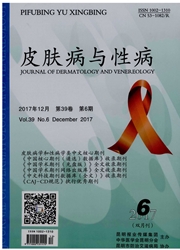

 中文摘要:
中文摘要:
目的从病原学方面探讨VVC和RVVC病原菌和药敏的差异,指导临床治疗。方法对VVC和RVVC的病原菌进行了鉴定并加以比较,并参照美国国家临床实验标准化委员会(NCCLS)推荐的M-27A方案,采用微量稀释法进行了分离菌株对常用抗真菌药物氟康唑、伊曲康唑及两性霉素B的体外药物敏感研究。结果VVC、RVVC组共分离出125株念珠菌,其中RVVC组67株,VVC组58株;在125株念珠菌中白念珠菌98株,占78.40%,非白念珠菌27株,占21.60%。RVVC组67株中有47株为白念珠菌,占68.66%(47/67);VVC组58株中有51株为白念珠菌,占87.93%(51/58)。RVVC组非白念珠菌所占比例与VVC组差异有统计学意义(P〈0.05),RVVC组非白念珠菌比例较高。念珠菌对三种药物敏感性依次为两性霉素B〉伊曲康唑〉氟康唑。非白念珠菌唑类药物敏感性低于白念珠菌。结论白念珠菌仍是VVC、RVVC的主要致病菌,RVVC组非白念珠菌比例高于VVC组,非白念珠菌中以光滑念珠菌比例最高。非白念珠菌对氟康唑的敏感率明显低于白念珠菌。
 英文摘要:
英文摘要:
Objectic To investigate the etiology and drug susceptibility in vulvovaginal cadidiasis and recurrent vulvovaginal candidiasis. Methods The candida isolated from patients with VVC and RVVC were cultured , purified and identified. Sensitivity of the isolates to fluconazole, amphotericin B and itraconazole was detected with checkerboard micro dilution method based on M-27A of NCCLS.Result The most common specie was Candida albicans (78.40%).There were 27 strains non-albicans in all the isolates (21.60%).There were 7 strains non-albicans spp among 58 strains in VVC group (12.07%) and 20 strains non-albicans spp among 67 strains in RVVC group(29.85%).The ratio of non-albicans in RVVC group was significantly higher than that of VVC group(P0.05). Non-albicans had lower sensitivity to azoles antifungal drugs compared with Candida albicans. The difference was significant in Fluconazole (P0.05).Conclusion Candida albicans was the most common specie in VVC and RVVC. Non-albicans spp was significantly higher in RVVC than in VVC. The non-albicans had lower sensitivity to Fluconazol.
 同期刊论文项目
同期刊论文项目
 同项目期刊论文
同项目期刊论文
 期刊信息
期刊信息
